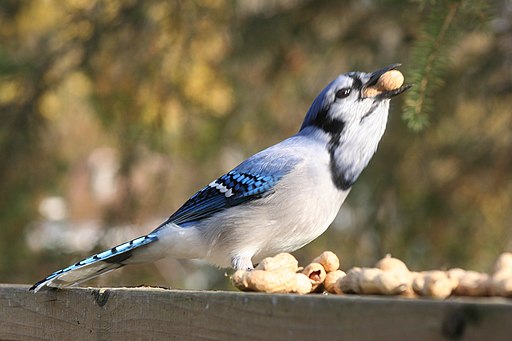Today we are looking at who is in the backyard and focusing on Blue Jays! Blue jays are very common around our house in Massachusetts. Unfortunately the ones that visit tend to be a little camera shy and I cannot get great shots of them.
Fun Facts About Blue Jays
- A blue jay is a member of the crow family.
- They can be 9 to 12 inches in length and have a wingspan of 13 to 17 inches. They weigh 2.5 to 3.5 ounces. They fly at a speed of 20 to 25 miles per hour, which is slow for a bird.
- A blue jay’s feathers are actually a dull brown. Their feathers have modified prismatic cells that scatter light waves reflecting the blue light to viewers. All the other colors of light go through the feathers.
- Male and female blue jays look the same. The male is slightly bigger than the female.
- A blue jay can imitate a Red-shouldered hawk or a Red-tailed hawk and confuse birdwatchers. They also imitate the Bald Eagle and the Eastern Screech Owl.
- There are four different subspecies of blue jays. They only have subtle differences.
- Blue jays are common in most of Eastern and Central North America and are slowly pushing the boundaries to the Northwest.
- Blue jays are migratory but typically don’t travel long distances and their migratory patterns are a mystery. Some years they will travel and the next they won’t. When they do the travel in flocks with up to 250 birds.
- Blue jays gather nuts in the fall for the winter. They store the nut in their expandable throat pouches and bring it to a save place to store it.
- Blue jays love acorns. They will grip the nut with their strong feet and then hammer it open with their black beak bill to get at the meat of the nut. Their love of acorns is credited with helping to spread oak trees after the last glacial period. They often forget about the acorn where they hid them and an oak tree grows.
- Blue jays will plunder the nests of smaller birds but usually get protein from insects, small animals and carrion. During nesting season other bird species are very cautious of a blue jay. I know I have seen it at my feeder.
- Blue jays mate for life. The couple builds the stick nest together and the male brings the female food while she incubates the eggs. She usually lays 2 to 7 bluish or brown eggs. The eggs incubate 16 to 18 days. He feeds her and the chicks the first few days after the hatching. The chicks stay with their parents as a family group throughout the summer and fall.
- Blue jays can live up to 7 years in the wild and up to 26 years in captivity.
- Blue jays are susceptible to the West Nile Virus. There numbers have been decreasing in recent decades because of this disease.
- Blue jays are very smart. Some in captivity use tools to get their food or to manipulate the lock on the cage. They are also known to sit back while humans eat and swoop down for the scraps when they are done. Farmers have recorded seeing them wait until they are done planting before the blue jays swoop down for the unplanted seeds.
- Blue jays practice anting. They spread their wings and tuck their tails down and crush and rub the ants all over themselves. This gets rid of the bitter formic acid from the ants and puts the acid on them to keep away bacteria, fungus, mites and more.
 |
| Blue Jay Range by Ken Thomas / Public domain |
 |
| Blue Jay by Jim Ridley 2010. / CC BY-SA |
 |
| Blue Jay with Peanut in Beak by Robert Taylor from Stirling, ON, Canada / CC BY |
Sources:
- American Bird Conservatory. “Blue Jay.” https://abcbirds.org/bird/blue-jay/
- Price, Jamie. Bird Watching HQ. “15 Fun & Interesting Facts about Blue Jays! [2020]” https://birdwatchinghq.com/blue-jay-facts/
- Soft Schools. “Blue Jay Facts.” https://www.softschools.com/facts/animals/blue_jay_facts/1139/
Blue Jay Crafts
I had only a couple people share blue jay crafts with me. I made a felt blue jay using the free pattern from Downeast Thunder Farm.
Bottom Left: Air Drying Clay Blue Jay from Red Ted ArtBottom Right: Paper Blue Jay Craft with Free Printable from Learn Create Love
Finally in case you want to share more about blue jays with your kids, here are some children's books that feature blue jays (for different ages).
I hope you have enjoyed our exploration of blue jays. Join us next week for our next backyard visitor!




